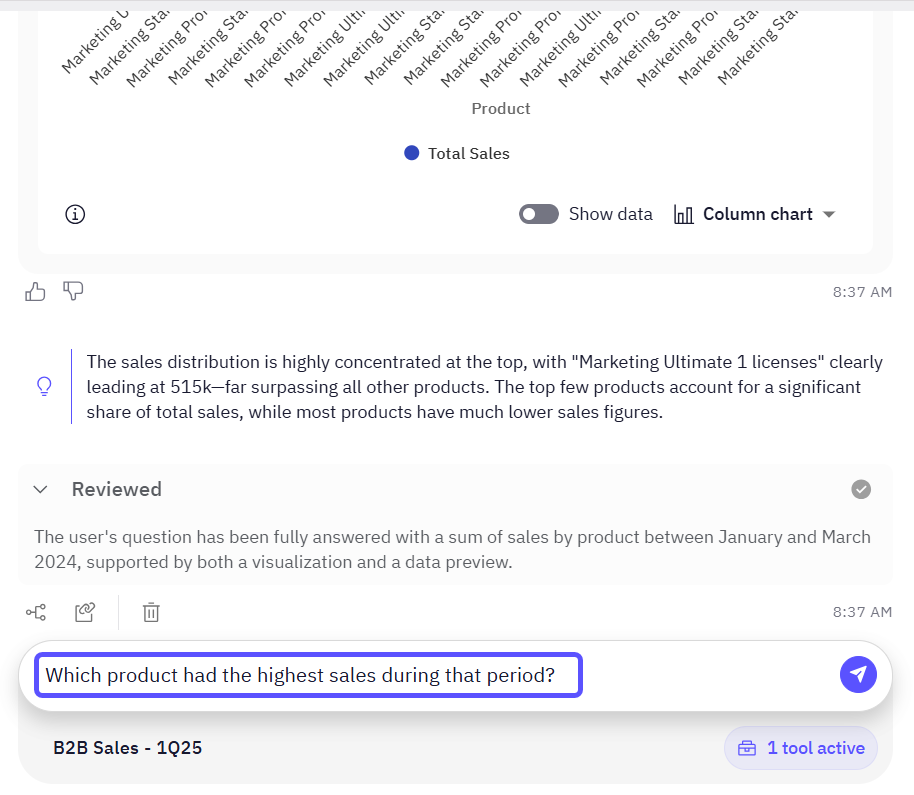Make Clear, Natural Language Questions
Use Filters for Better Focus
Plan for Follow-up Questions
Use Business Terms Set by Admins
Make Clear, Natural Language Questions
WisdomAI understands everyday language, but being clear helps it understand you better.- Be Specific: Instead of “Show sales,” ask “Show total sales for the last quarter.”
- Use Exact Words: Say “Count of customers who bought in the last 30 days,” not “Customers buying stuff.”
- Ask for Summaries: If you want totals or averages, say so. For example, “Sum of sales by product” or “Average sales per product.”
- State Time: Always include dates or periods like “Last month” or “Between January and March 2024.”
- Hint at Connections: Use words like “by,” “who bought,” or “per” to show relationships. For example, “Sales by region.”
- Try Different Ways: If a question doesn’t work, try phrasing it differently.
Ask a Question
- Navigate to the Search window in the left sidebar. The Chat page will open.
- Send a question to the chat.
- The chat will start preparing the answer. You will be able to see its Workstream:
- The tool (tabular data or textual) selected,
- The step-by-step process,
- Any join constraint validation,
- The final query.

Use Filters for Better Focus
Filters help you narrow down your data to exactly what you need.- Set Conditions: Don’t just ask for “customers”; ask for “customers in the US” or “customers who spent over $500.”
- Use Comparisons:
- Equal:
where Region is 'North' - More/Less:
where Sales > 1000 - Range:
where Date between '2024-01-01' and '2024-03-31' - Contains:
where Product Name contains 'Pro'
- Equal:
- Combine Filters: Use “and,” “or,” and “not” for more detailed questions. For example, “Sales where Product Category is ‘Apparel’ AND Region is ‘West’.”
- Exclude Things: Sometimes it is easier to say what you don’t want. For example, “All customers except those in California.”
Add or Adjust Filters
After WisdomAI provides you with the answer, you will be able to:- See the applied filters, according to your question, e.g., Stage Label, Dates, etc.
- Add one or more filters, such as Lead Source. Here, you also have the option to clear all filters.

Plan for Follow-up Questions
One question rarely gives the whole picture. Think about what you’ll ask next to dig deeper.- Start Broad, Then Detail: Begin with a general question, then ask for more specifics.
- First: “What were our total sales last quarter?”
- Next: “Which products sold the most?”
- Then: “How did our top product sell over the last year?”
- Explore Surprises: If something looks odd, ask why.
- Problem: “Sales in one area dropped last month.”
- Ask: “What marketing happened there?” or “Were there many returns?”
- Compare Things: Look for differences and similarities.
- Question: “How do costs in Q1 compare to Q2?”
- Ask: “What caused that difference?”
- Look at Different Angles: If you are looking at sales by area, next look at sales by product or by customer.

Use Business Terms Set by Admins
Your organization has a shared language for its data. Using these official terms is key.- What are Business Terms?
- They are the official words your company uses.
- They define what “Customer,” “Revenue,” or “Active User” really mean for your business.
- Admins usually create and manage them, often in a business glossary.
- Why Are They Important?
- Everyone Understands: Ensures everyone means the same thing by “Sales.”
- Correct Answers: Prevents mistakes and helps you query the right data.
- Save Time: Less time spent explaining terms.
- Trust Your Data: When terms are clear, data is more reliable.
- Better Questions: Helps you use the exact words WisdomAI understands.
- How to Use Them:
- Check Your Company’s Glossary: Always look up terms there first.
- Use Exact Words: If “Sales” is officially “Total Recognized Sales (USD),” use that.
- Understand What’s Behind It: Even if you don’t use database names, knowing how a term like “Active Customer” is defined (e.g., active in the last 90 days) helps you ask better questions.
- Ask if Unsure: If a term is unclear, ask your data team. This helps everyone.
- Help Others: Encourage colleagues to use the standard terms, too.
Next Steps
Advanced Data Modeling
Define relationships and context in your data to enable more powerful analysis.
Validate and Test Answers
Understand the methods for verifying the correctness and reliability of generated answers.
Provide Feedback to the System
Learn how to rate answers and provide corrections to improve the system’s accuracy.
Turn Answers into Stories
Compile key insights and visualizations into a shareable, narrative-driven report.